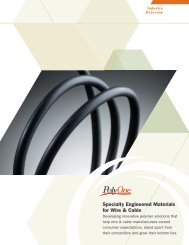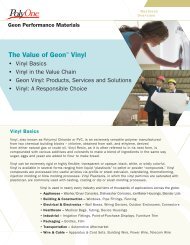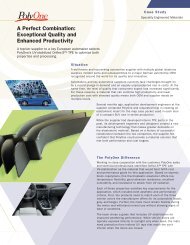Create successful ePaper yourself
Turn your PDF publications into a flip-book with our unique Google optimized e-Paper software.
<strong>Stan</strong>-Tone PEP <strong>Colors</strong><br />
• Description: Selected organic<br />
and inorganic pigments<br />
dispersed in a polyester<br />
plasticizer.<br />
• Carrier: Diethylene glycol<br />
adipate, 2,000 molecular wt.,<br />
54 hydroxyl number.<br />
• Product Form: Liquid to paste<br />
(varying viscosity).<br />
• Application/End Use: For use<br />
in a variety of thermoset<br />
polyester systems (polyester<br />
resin composites & polyester<br />
polyurethane systems) including<br />
wheels & industrial rollers, rigid<br />
foam, adhesives, laminates, etc.<br />
Typical recommended use<br />
level: 1.0% – 5.0% by weight.<br />
• <strong>Stan</strong>dard Packaging: 5-gallon<br />
plastic pail, 30-gallon fiber<br />
drum, 55-gallon steel drum.<br />
• Shelf Life: Typically one year<br />
from the date of manufacture<br />
when stored under proper<br />
conditions in original, sealed<br />
container. Mix prior to use.<br />
• Order Size/Sample Size:<br />
Minimum order: 5-gallon pail.<br />
1/2-pint sample available<br />
upon request.<br />
Polyester Urethane Paste <strong>Colors</strong> (PEP)<br />
<strong>Stan</strong>-Tone <br />
<strong>Colors</strong>
Key<br />
RS = Red Shade<br />
YS = Yellow Shade<br />
VYS = Very Yellow Shade<br />
BS = Blue Shade<br />
VBS = Very Blue Shade<br />
GS = Green Shade<br />
HR = Heat-Resistant<br />
(a) = Heavy Metal Pigment<br />
Lightfastness<br />
I = Indoor Only<br />
I/O = Indoor or Outdoor<br />
Mass = Outdoor Masstone<br />
Application Only<br />
C = Some Caution Advised<br />
<strong>Stan</strong>-Tone Pigment Type Approx. % Specific Color Lightfastness<br />
Code Pigment Gravity Index<br />
White<br />
10PEP03 Titanium Dioxide, Rutile 60.0 2.06 PW-6 I/O<br />
Yellow<br />
12PEP01 Diarylide AAOT GS 20.0 1.24 PY-14 I<br />
12PEP03 Diarylide HR RS 25.0 1.23 PY-83 I/O (Mass)<br />
13PEP02 Isoindolinone RS 25.0 1.31 PY-110 I/O<br />
13PEP03 Benzimidazolone GS 25.0 1.25 PY-151 I/O (Mass)<br />
30PEP01 (a) Primrose Chrome GS 60.0 2.26 PY-34 I/O C<br />
30PEP03 (a) Medium Chrome RS 60.0 2.26 PY-34 I/O C<br />
81PEP01 Iron Oxide 60.0 2.07 PY-42 I/O<br />
Orange<br />
15PEP02 (a) Molybdate RS 65.0 2.41 PR-104 I/O C<br />
15PEP03 Benzimidazolone RS 25.0 1.27 PO-36 I/O<br />
Red<br />
23PEP04 Quinacridone BS 25.0 1.24 PV-19 I/O<br />
23PEP06 Specialty Naphthol BS 25.0 1.23 PR-170 I/O (Mass) C<br />
25PEP01 Red 2B, Ca Salt BS 17.0 1.26 PR-48:2 I/O (Mass)<br />
28PEP01 (a) Red 2B, Ba Salt YS 25.0 1.32 PR-48:1 I/O (Mass)<br />
82PEP01 Iron Oxide, Light YS 27.0 1.50 PR-101 I/O<br />
82PEP02 Iron Oxide, Light BS 60.0 2.20 PR-101 I/O<br />
82PEP04 Iron Oxide, Light VYS 60.0 2.20 PR-101 I/O<br />
82PEP05 Iron Oxide, Dark VBS 60.0 2.21 PR-101 I/O<br />
<strong>Stan</strong>-Tone Color Dispersions for Castable Polyurethanes<br />
<strong>Stan</strong>-Tone pigment dispersions find broad application in thermoset castable polyurethane systems.<br />
Selection of the best pigment dispersion is dependent on a number of factors: the specific urethane<br />
system, the fabrication/processing methods, the end-use requirements, the economics, etc.<br />
Vehicle Type<br />
The primary requirement is the selection of the vehicle compatible with the particular urethane<br />
system. For our purposes, urethane systems can be categorized into two basic types: polyethers and<br />
polyesters. These vehicles fall into the categories of nonreactive and reactive. Most urethane systems<br />
are based on two components, typically a “prepolymer” and “polyol.” The nonreactive vehicles can<br />
be added to either component. It is recommended that the reactive vehicles be mixed with the polyol<br />
portion. Mixing reactive vehicles with the prepolymer should be carefully evaluated and tested on<br />
an application-by-application basis, because it could result in shortened pot life and/or inferior<br />
physical properties.<br />
Polyester-Based Systems<br />
<strong>Stan</strong>-Tone PEP colors (diethylene glycol adipate) are reactive and compatible with polyester<br />
systems, reacting to become part of the final cured product. In addition to their use in polyester<br />
polyurethanes, <strong>Stan</strong>-Tone PEP colorants find use in a variety of thermoset polyester systems for<br />
applications such as pultrusion, cast polymer countertops, glass-reinforced composites and coated<br />
fabrics. <strong>PolyOne</strong> offers a custom PEP vehicle system especially suitable for gelcote applications.<br />
Polyether-Based Systems<br />
<strong>Stan</strong>-Tone ET colors (polyether triol) are reactive and highly compatible with polyether systems<br />
reacting to become part of the final cured polymer. Refer to <strong>PolyOne</strong>’s <strong>Stan</strong>-Tone Polyether<br />
Urethane Paste <strong>Colors</strong> (ET) brochure for further details.
<strong>Stan</strong>-Tone Pigment Type Approx. % Specific Color Lightfastness<br />
Code Pigment Gravity Index<br />
Blue<br />
40PEP01 Phthalocyanine GS 25.0 1.27 PB-15:3 I/O<br />
40PEP05 Phthalocyanine RS 25.0 1.27 PB-15 I/O<br />
42PEP02 Ultramarine 35.0 1.44 PB-29 I/O<br />
49PEP01 Cobalt 31.0 1.54 PB-28 I/O<br />
Green<br />
50PEP01 Phthalocyanine BS 16.0 1.28 PG-7 I/O<br />
50PEP03 Phthalocyanine YS 16.0 1.28 PG-7 I/O<br />
59PEP02 (a) Chromium Oxide 70.0 2.60 PG-17 I/O<br />
Violet/Magenta<br />
24PEP02 Carbazole Violet 13.0 1.22 PV-23 I/O<br />
24PEP03 Quinacridone Violet 20.0 1.24 PV-19 I/O<br />
24PEP04 Ultramarine Violet 50.0 1.69 PV-15 I/O<br />
24PEP05 Quinacridone Magenta 20.0 1.24 PR-122 I/O<br />
24PEP06 Benzimidazolone 20.0 1.23 PV-32 I/O<br />
Brown/Tan<br />
83PEP01 Iron Oxide, Light 34.0 1.60 PBr-6 I/O<br />
83PEP02 Iron Oxide, Dark 29.0 1.51 PBr-6 I/O<br />
Black<br />
90PEP01 Furnace – High Jet 24.0 1.30 PBk-7 I/O<br />
90PEP04 Furnace – Medium 17.0 1.27 PBk-7 I/O<br />
90PEP05 Iron Oxide 33.0 1.58 PBk-11 I/O<br />
<strong>Stan</strong>-Tone DIDP paste colors are compatible with polyether systems but are nonreactive. While the DIDP acts as a diluent in the<br />
system, the relatively small amounts (approximately 3% maximum) should have only minor effects on the physical properties in<br />
normal situations. Refer to <strong>PolyOne</strong>’s <strong>Stan</strong>-Tone Vinyl Paste <strong>Colors</strong> (HCC) brochure for further details, and test to verify<br />
compatibility and performance.<br />
Viscosity Range<br />
<strong>Stan</strong>-Tone dispersions can be supplied in a range of viscosities to meet most requirements. Selection of a suitable viscosity is<br />
dependent on the particular processing techniques employed by the user. The fabricator who is hand-mixing small batches might<br />
prefer a higher viscosity (buttery) paste for ease of weighing and handling. On the other hand, a metering pump/mixing chamber<br />
setup would typically use a more pumpable, nonsettling, low-viscosity dispersion. The tendency for a pigment to settle-out increases<br />
when the viscosity is lowered; therefore, premixing at the pump is recommended.<br />
Pigment Type<br />
Selection of the pigment type is determined by the end-use requirements, such as indoor or outdoor (lightfastness), toxicity,<br />
heat stability, etc.<br />
Urethane systems based on aromatic isocyanates (MDI, TDI) exhibit inherent color-stability problems (darkening and yellowing)<br />
due to UV degradation and/or aging. Aliphatic isocyanate systems offer better light stability, but are more prone to react with<br />
moisture contamination than the aromatic systems. The type of system being colored will affect the perceived performance of the<br />
pigment system over time, and users may wish to perform color-aging tests to verify desired long-term results.<br />
Special Dispersions<br />
<strong>Stan</strong>-Tone dispersions are also available in a variety of other vehicles including dipropylene glycol dibenzoate, which has the<br />
advantage of compatibility in both polyether and polyester systems. Customer-specified carrier systems and custom-color match<br />
pigment blends are available on a made-to-order basis.<br />
Specific questions or problem areas can be discussed with your <strong>PolyOne</strong> Technical Specialist.
With respect to the foregoing information, <strong>PolyOne</strong> makes no representations, guarantees or warranties of any kind with respect to its accuracy, suitability<br />
for particular applications or the results obtained or obtainable through its use. <strong>PolyOne</strong> obtained the foregoing information generally based on<br />
laboratory work with small-scale equipment, which may not provide a reliable indication of performance or properties obtained or obtainable on largerscale<br />
equipment. Because of variations in methods, conditions and equipment used commercially in processing these materials, <strong>PolyOne</strong> cannot warrant<br />
or guarantee the suitability of <strong>PolyOne</strong>’s products or the information for a User’s application or for the conditions disclosed in the foregoing information.<br />
User has all responsibility for full-scale testing and end-product performance. <strong>PolyOne</strong> shall have no liability for, and the customer assumes all risk and<br />
liability of, any use of the foregoing information and/or use or handling of any material relating to the foregoing information. POLYONE MAKES NO<br />
WARRANTIES, EXPRESS OR IMPLIED, INCLUDING, BUT NOT LIMITED TO, IMPLIED WARRANTIES OF MERCHANTABILITY AND<br />
FITNESS FOR A PARTICULAR PURPOSE, either with respect to the foregoing information or products relating thereto.<br />
<strong>PolyOne</strong> Corporation<br />
33587 Walker Road<br />
Avon Lake, OH 44012<br />
1.866.POLYONE<br />
(1.866.765.9663)<br />
www.polyone.com<br />
<strong>Stan</strong>-Tone colorants are manufactured at <strong>PolyOne</strong>’s state-of-the-art facility<br />
located in Massillon, Ohio. For more information, call 1-866-POLYONE or<br />
e-mail us via our Web site at www.polyone.com.<br />
At <strong>PolyOne</strong>, we deliver premium-quality<br />
products and services, which our customers<br />
use to enhance their own products. We believe<br />
no competitor can match our technical<br />
expertise because no workforce can outperform<br />
the people of <strong>PolyOne</strong>. Our people are ONE<br />
team working together – our strength and our<br />
pride. Their skills, passion and dedication are<br />
shaping a potent industry leader, a concerned<br />
corporate citizen and a great place to work.<br />
© 2005, <strong>PolyOne</strong> ® Corporation<br />
All Rights Reserved<br />
STPEPB-01-70448


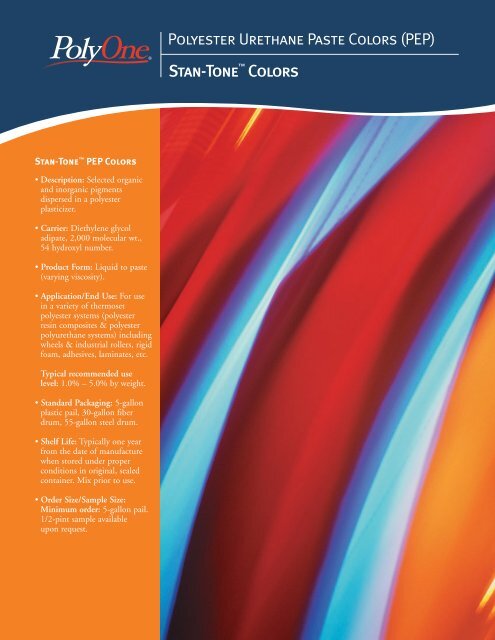
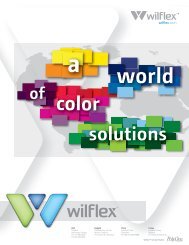
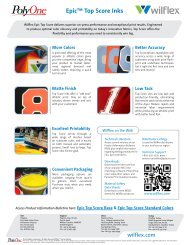
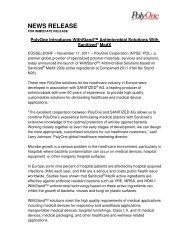

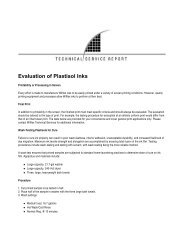
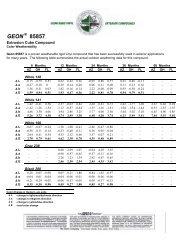
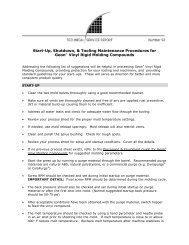
![TPE Injection Molding Guide [PDF] - GLS Thermoplastic Elastomers](https://img.yumpu.com/26329362/1/190x245/tpe-injection-molding-guide-pdf-gls-thermoplastic-elastomers.jpg?quality=85)

